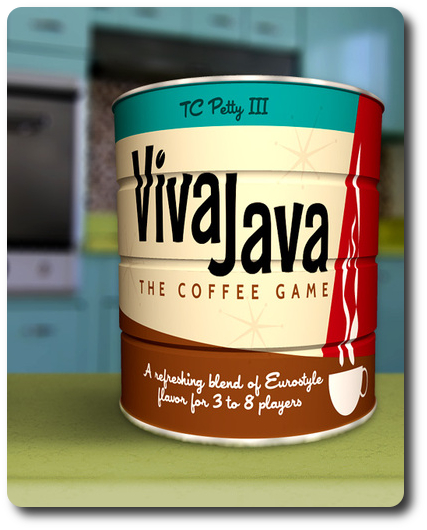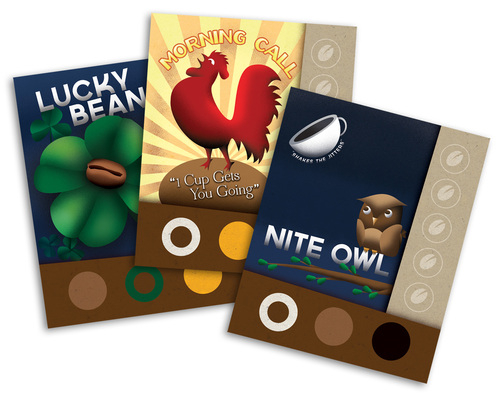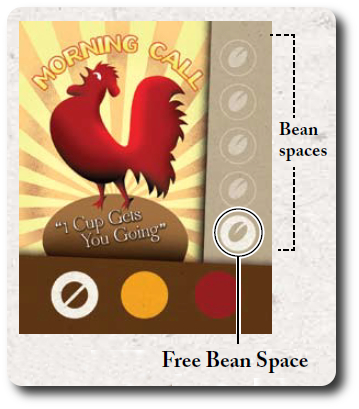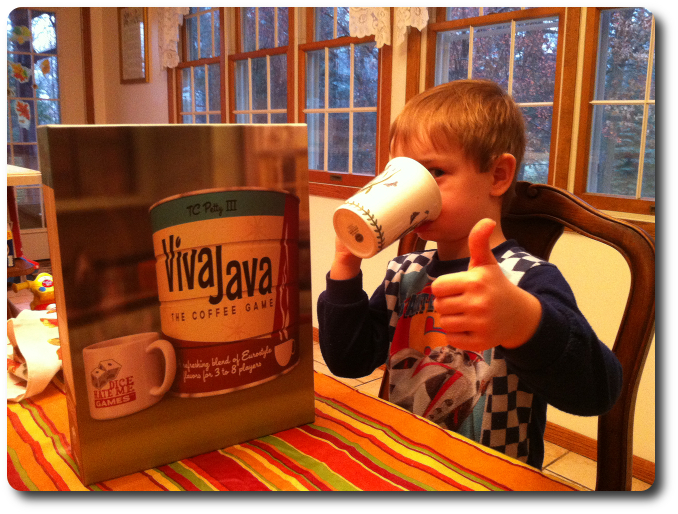
The Basics:
- For ages 13 and up
- For 3 to 8 players
- Approximately 90 minutes to complete
Geeks Skills:
- Active Listening & Communication
- Counting & Math
- Logical & Critical Decision Making
- Memorization & Pattern/Color Matching
- Strategy & Tactics
- Cooperative & Team Play
- Hand/Resource Management
- Bluffing and Misdirection
- Worker Placement
Learning Curve:
- Child – Moderate
- Adult – Easy
Theme & Narrative:
- Search the world over for the perfect blend of coffee beans to make the perfect coffee!
Endorsements:
- Gamer Geek approved!
- Parent Geek mixed!
- Child Geek rejected!
Overview
Cup after cup after cup, people can’t seem to get enough coffee! Be it served with cream, foam, syrup , hot, or cold, the market just keeps drinking! But the consumers quickly grow tired of the same-old-same-old and yearn for new tastes and ways to enjoy the coffee bean. That’s where you come in. You have been tasked to blend new beans, research new techniques, and dominate the best-seller list. But you can’t do it alone.
VivaJava, by game designer T.C. Petty III and published by Dice Hate Me Games, is comprised of 1 World Map game board, 1 Performance Track/Best-Seller List game board, 15 Blend Slates, 2 Starter Slates, 2 Variant Slates, 1 Stale Marker, 8 double-sided Research Labs, 16 Flavor cards, 24 Intern cards, 8 Player Reference cards, 8 Featured Blend cards, 8 Blend/Research coins, 9 Country tokens, 8 Roaster Purge coins, 15 Investment tokens, 8 fabric Roaster bags, 90 wooden Coffee Beans (in six different colors), 8 wooden Field Researcher pawns, 8 wooden Scoring tokens, 40 Research markers (8 sets of 5), 24 Player Blend markers (8 sets of 3), and 8 Turn Order tokens. Phew! Sound like a lot for one game? It is, but VivaJava includes components for multiple game variants, which means that everything in the game box is not used all at once. What’s in the game box, however, is absolute quality.

Game Set Up
To set up the game, first unfold the World Map and the Performance Track/Best-Seller List game boards and place them in the middle of the playing area one above the other, make sure to leave room between the two game boards.
Second, separate the 90 Coffee Beans by color and place them in piles under the World Map. For each colored Coffee Bean, there is a noted “column” on the bottom edge of the World Map. This area is referred to as the “Field” in the game.
Third, shuffle the Blend Slates and place them near the World Map, face-down. Draw the first 3 Blend Slates and place them, one at a time going left to right, on the designated column on the top edge of the World Map. Shuffle the Flavor cards and place them to one side, face-down.

Fourth, place the Score tokens in a Roaster bag and randomly pull out one at a time and place them on the Performance Track/Best-Seller game board in accordance to the number of players.
Fifth, take and place the two Starter Slates under the “Swell” and “Top Cup” column on the bottom edge of the Performance Track/Best-Seller game board. “Average Joe” should be under “Top Cup” and “7:45 AM” should be under “Swell”. At this time, take Coffee Beans from the Field that match the colored column of Coffee Beans on the Starter Slates and place them on each Coffee Bean icon (one per icon).
Sixth, place the Coffee Beans in the Field on the Country Crop circle spaces on the World Map, based on the colors represented on the Blend Slates. Note that the World Map is divided into three regions. Each region has a Blend Slate assigned to it.

Seventh, shuffle the Country tokens with the special actions and randomly place them on the World Map in the circle Country Crop spaces in each of the regions.
Eighth, give each player a set of pieces of the player’s selected color, 1 Field Researcher, 1 Roaster bag, 1 Research Lab and 1 Player Reference card. A Research marker should also be given to each player and these are placed on the players’ starting positions for each research track on the Research Lab.
Ninth, each player takes 1 yellow Coffee Bean and 2 white Coffee Beans from the Field, placing them in their Roaster bag.
If Playing with 3 to 6 Players…
The Blend Slates will have a special symbol on them that indicates that an action must be performed for the specific region where the Blend Slate is located. Tokens are placed in the areas where indicated by the Blend Slate, often resulting in no Coffee Bean being added to a specific spot. The Country tokens are doubled-sided, allowing for easy game set up and use of the same token as needed.
If Playing with 3 to 5 Players…
The “Coffee*” Blend Slate is permanently placed (as in, never is removed for the duration of the game) in the “Stale” column on the bottom edge of the Performance Track/Best-Seller game board.
That’s it for game set up. It is suggested that one player take on the role of “Brewmaster” who is responsible for assigning the Turn Order tokens and controlling the movement of the Scoring tokens on the Performance Track/Best-Seller game board. Based on personal experience, this should always be done to keep the game play going smoothly.
Making a Really Good Cup of Joe
Note: VivaJava can be very involved at times, depending on the number of players in the game. This is because VivaJava is a very social game that requires semi-cooperative game play in order for all the players to attempt to meet their goals. The game rules book is quite large (20 pages long), with lots of details and visual examples to help the reader learn how to play the game. We will only summarize the game play here and suggest you read the rules for full details.
VivaJava is played over a series of rounds in which all the players will be participating in 3 phrases that make up the round. A round is summarized here.
Phase 1: In the Field
The first phase of the game is focused on collecting Coffee Beans from the three regions on the World Map. Players will take turns in turn order sequence (determined by the Scoring tokens) with the player with the lowest score going first, followed by the next lowest score, and so on until every player has had a turn. To help keep track of the turn order sequence, the Brewmaster should place the Turn Order tokens on the Turn Order track in the right order.
During their turn, the player will take and place their Field Researcher in one of the circles on the World Map. Whatever Country token is currently placed on that same position is immediately resolved and the Coffee Bean that is associated with that circle is collected and placed in the player’s Roaster bag. Note that positive Country tokens are optional, but negative Country tokens must always be resolved. During the first round of the game, all negative Country tokens are ignored.
Once all the player’s have placed their Field Researcher, the next phase is triggered. Players cannot select the same circle as another player, nor can they select a circle with a crossed out symbol (unless a special actions allows it). Discussing where players should and should not place their Field Researchers is permissible and highly encouraged during this phase.
Phase 2: Blend or Research
The second phase starts with a vote. The players who have placed their Field Researchers in the same region are a “team”. As a team, they must vote to either work together to attempt to create a new blend of coffee or go their own way and quietly work in their research labs. Teams can take a minute or two to argue why their fellow team members should or should not vote a certain way. When the discussion have been completed, each player on the team takes their Blend/Research token in their hand and secretly decides on which side they want the token to be revealed (in accordance to how they want the vote to conclude). Simultaneously, all the team members will reveal their token. The majority vote determines the team’s action for this round with no exceptions. All ties, and if a team cannot collectively provide 5 beans from their Roaster bags, default to research.
One team need not wait for another during this phase. The three teams should discuss and vote simultaneously.
If the team has voted to blend, the Blend Slate is taken that is currently occupying the same column as the team’s region. Each Blend Slate will have 5 Coffee Bean spaces to be filled via random pulls from each team member’s Roaster bag. One at a time (in any order the team likes), the players will pull 1 Coffee Bean randomly from their Roaster bag and place it on the Blend Slate. The player can continue to add Coffee Beans, but must stop so that every team member can provide at least 1 Coffee Bean each. Once a player stops pulling Coffee Beans, they cannot provide any further Coffee Beans to the Blend Slate. Note that some Blend Slates have a “free Coffee Bean” space that automatically gets filled from the Field, but only if a Coffee Bean of that color is available. If not, the players must fill it from their Roaster bags (using any color).

Once filled, the Blend Slate is placed on the Best-Sellers list with an Investor token for each player who helped contribute to it. Where it is placed is dependent on the blend’s Roaster Ranking. A Roaster Ranking is much like a Poker hand. For example, having 5 Coffee Beans of the same color is a better blend than one created that has only 2 Coffee Beans of the same color.
Blends move down in popularity by sliding to the left. If a new blend has a higher Roaster Ranking than another blend that is currently available, it bumps it, taking its place, and shifting everything from that position to the left. Any Blend Slates moved all the way to the left and off, are removed from play and the Coffee Beans are returned to the Field. All Investment tokens are returned to the general supply.
Due to the knowledge the team has obtained through working together, each player is awarded 1 Research Point they can use to improve their research tracks.
If the team has voted to research, each player has 3 Research Points to spend to improve their positions on their own individual research tracks. Players choose where they want to distribute their points and are not required to discuss how or why they spend them with their fellow team members. Each spot on the track is worth 1 Research Point. The first spot in each of the Research Lab columns is marked with a starburst that indicates that the player has reached a new level of understanding thanks to their lab work. The column provides a special ability that the player can use during the next round of play. Players who choose to research can also trade in Performance Points (the points that count towards victory) to add another Research Point, at a 1 to 1 trade.

Once all the teams have finished with their voted for actions, the next phase is triggered.
Phase 3: Popular Opinion
The third phase starts with awarding players with Performance Points based on their blend’s current popular standing. Each Blend Slate will be located under a column that provides a number of Performance Points. A player is awarded those Performance Points only if they have an Investment token on the Blend Slate in question. Scoring tokens are moved accordingly on the track.
After all the blends have been looked at and all players who have Investment tokens have scored, the blends naturally degrade. From each Blend Slate, a single Coffee Bean is removed and placed back in the Field. The Coffee Bean to be removed should be the one that has the least amount of impact to the Blend Slate’s Roaster Ranking. Note that “Rainbow Blends”, those blends that have 1 Coffee Bean of every color, never degrade! These are very special blends, but the Best-Seller list can only support one such blend at a time. (Sorry, no double rainbows.)
After all the Blend Slates have been updated, the Brewmaster shifts all the remaining Blend Slates on the World Map to the right, filling in the gaps. A new Blend Slate is drawn for any empty columns. All Coffee Beans in the regions that were not claimed are returned to the Field, and then all the regions are filled, from left to right. Any circles that cannot be filled are left empty. If all the teams research, the right most Blend Slate is removed from the game.
This ends the round.
Emptying the Coffee Cup
The game can end several different ways.
- Not Enough Blend Slates: If the Brewmaster is ever unable to refill the columns above the World Map during the final phase of the round, the game comes to an end.
- Four End-Track Abilities: If at anytime during the round a player successfully reached the end of all of their research tracks, the game comes to an end.
- Twenty-One Performance Points: If at anytime during the round a player has successfully obtained 21 or more Performance Points, the game comes to an end.
In turn order sequence, players add up all their Performance Points gained from research and any bonuses. The player with the most Performance Points wins the game.
Lots and Lots of Game Variants
VivaJava is packed full of a number of game variants that can be used by the players if they want to enhance or change their game play experience. They are summarized here.
- Decaffeinated VivaJava: The Research Lab has an easier side that can be used if introducing the game to new players. This game variant also removes the Flavor cards from the game.
- Interns: For a 3-4 player game, “Interns” can be used to help players in the Field or in the lab, but because they are interns and not very skilled, there have negative consequences when used. Note that using this expansion (actually referred to as an “inspansion”) changes game set up, play, and ending game scoring.
- Variable Starter Beans: Instead of taking the standard starting Coffee Beans, the players randomly draws 3 Intern cards and places whatever Coffee Bean is shown into their Roaster bag.
- Roaster Purge Coins: This game variant (recommended as a learning aid) provides each player with a special Roaster Purge Coin that can be turned in after a round that allows the player to remove all the Coffee Beans from their Roaster bag.
- Featured Blend Cards: This game variant is only available for games that have 5 to 6 players. The new Blend Slates add more Coffee Beans that can be collected during the game.
- Flavor Card Draft: At the start of the game, each player is dealt 2 Flavor cards. Players choose 1 and discard the second.
- Variable Country Tokens: At the end of the round, and only after Field Researchers have been returned to their owning player, the Brewmaster collects all the Country tokens and redistributes them in the same way it was done during the game’s initial set up.
To learn more about VivaJava, see the game’s official web page. We’ve most likely forgotten to mention something about the game, despite our best efforts to summarize it for you. Do take a look at the game’s rule book for the full details.
Prediction
Good grief, this game looks like a nightmare to pull together and teach to different gaming groups. SO MANY PIECES!!!! I don’t think the Gamer Geeks are going to have much trouble with it, but the Parent Geeks might take a little bit of work. This is especially true if any non-gamers are joining us and are not familiar with Euro-style games where smart resource use is a must. But is this a Euro-style game? Seems like it to me. I heard one Gamer Geek describe it as a Euro-style “party game”, but I don’t see it from just looking at the rules. It does appear to be a game that requires all the players work together, but that isn’t a party. Heck, I work with people all the time, but you won’t see me with a party hat or a balloon at the office.
Well, not unless it’s someone’s birthday…
For the Child Geeks, I don’t think this is a complicated game to teach (no more complicated than teaching it to the Parent Geeks). The phases are very straight forward and what actions that can be taken are clear and meaningful. While it will be easy to teach, it won’t be an easy experience to grasp. There is a lot of strategy and tactics that are completely dependent on keeping track of what you have in your Roaster bag and what you “think” your opponents have in theirs. You must manage your own resources, and when working on the vote to determine blending or researching, subtly suggesting how other team members should use their resources is necessary. That’s not something you can teach. To fully understand what this game is about, a player must have a certain level of experience and be able to carefully observe the game and their opponents. Child Geeks have supernatural powers when it comes to observation, but lack the experience to make what they see stick without context. That game length might also be a problem for the Child Geeks.
As I thought, teaching the game to my 8-year-old wasn’t that difficult. The three phases were easy to explain and he had no questions about what he needed to do during each. He was very excited about the Coffee Bean pulls during blends, however, and wanted to know how he could possibly make a really good coffee. I told him that was not fully his responsibility and he might need the help of others. When he asked how he would know if others would or could help, I suggested that was up to them and up to him to know what his opponent’s had in their Roaster bags. He remained unconvinced. And so, as I reset the game for our first play with 2 others, I asked him his thoughts on the game so far.
“I understand it, but I don’t get it.” ~ Liam (age 8)
Very insightful. I think he truly does understand the procedural portion of the game, but has not yet fully wrapped his mind around the game as a whole. Let’s play and see if VivaJava is robust and flavorful or bitter and unpleasant.
Final Word
We tried to play VivaJava with our Child Geeks several times, but it never stuck. When we asked why the game wasn’t that interesting to them, the Child Geeks said it was too long and hinted that the game’s theme and narrative was simply nothing they cared about. In truth, you don’t need to know anything about coffee or even drink it to play VivaJava, but in the case of the Child Geeks, it certainly would have helped. It is important to note that Child Geeks as young as 8-years-old were able to play this game and do well, but never made it through an entire game. The game is moderately difficult for the Child Geeks, however, as there is a lot to keep track of. How many and of what color Coffee Beans in both the player’s and the opponents’ bags, for example, is something that must always be kept in mind. When it was all said and done, the Child Geeks just didn’t think the game was all that interesting to them.
The Parent Geeks were a mixed bag. For those Parent Geeks who were already familiar with Euro-style games, they sat down and very much enjoyed VivaJava. They found the game’s play and flow to be very engaging and loved the player interaction. For those Parent Geeks who were not fans of Euro-style games, VivaJava fell flat, despite the majority of them being hardcore coffee drinkers. According to one Parent Geek who did enjoy the game, “this is like no other game I have ever played, and yet it is using game mechanics that I am familiar with which makes the game easy to learn and lot of fun to play!” And according to one of the Parent Geeks who didn’t care for the game, “I understand what I am supposed to do, but I just don’t feel that what I am doing is very entertaining – I’d rather just drink coffee.” It turned out to be an even split with the Parent Geeks and the endorsement remained mixed. From what we observed, for the Parent Geeks and casual gamers who enjoyed Euro-styles games, VivaJava was well received.
The Gamer Geeks didn’t care for this game until 7 to 8 players were at the table. That’s when VivaJava really shines and dominates the player’s attention and imagination. With so many players, there is a lot of deals to broker, promises to be made (but not necessarily kept), and a lot of watching what opponents are doing. The Gamer Geeks found the random pulls from the Roaster bag to be fairly annoying at first until they started to see it as a resource they had to control. It is very hard to win against skilled players if you don’t pay attention to what Coffee Beans you are collecting and attempt to be a majority owner of certain colors. The Gamer Geeks, when they started to see this, suddenly saw VivaJava in a new light and the games got really interesting. The momentum builds, negotiations get heated before team votes, and the competition was fierce. And yet, all the players had to “play nice” with each other in order to make points. In some ways, VivaJava is very much a cooperative game, but there can only be one winner in the end, making it a semi-cooperative. When the games were over and the points were scored, the Gamer Geeks decided that it was well worth their time and voted to approve it. It is worth noting that the majority of Gamer Geeks didn’t much care for the game’s theme or narrative, finding it to be of little use and of almost zero value to overall game play. “This could be a game about collecting pizza toppings and it would still work”, suggested one Gamer Geek.

A tired group of Gamer Geeks playing the game – NEED MORE CAFFEINE!!!
This game took me a long time to review. Not because it is hard, but because the game play is surprisingly different depending on the number of players you have at the table. VivaJava is very much a “social game” that plays best with 8 players, and then slightly changes as the number of players decreases. Balance is always maintained, but more rules are necessary as a result. If you are playing with smaller numbers, what is available to you on the game boards is reduced and you must play very differently to work together to make blends. With lots of players, you don’t have to work very hard to make blends, but you have to work very hard to make sure the Coffee Bean distribution is in your favor with a constant focus on balancing cooperative blends with individual player points.
When I first played VivaJava with my weekly gaming group (with a total of 4 players), it fell somewhat flat. We were tired and we didn’t have much energy in the way of being social. That’s a big mistake for VivaJava. You need to be at the table and engaging the other players, looking at their Research Lab, trying to keep track of what Coffee Beans are being taken, and attempt to negotiate Coffee Bean distribution so it is always beneficial. But not so beneficial that it lets your opponents’ get ahead. When I played the game again with a mixed group of Parent Geeks, the energy level was higher and the game really clicked. Everyone at the table felt it, too, and the game was less about coffee and more about the people playing the game.
I really like VivaJava, but it’s not a game I will place on the table unless a few very important conditions are met. First, there has to be at least 7 or 8 players. The more players the game has, the more fun it is. I had the most fun with the game with a full table. Second, all the players I sit down with need to engage the game and their opponents fully. VivaJava can take a really long time if you don’t have players who are actively participating. Most of the time, all the players are playing simultaneously, but a round is only as fast as the slowest player. Third, VivaJava can be a real bore if players don’t interact. I only want to play VivaJava with players who aren’t afraid to speak up and argue. You need to negotiate how many Coffee Beans players are going to pull, suggest what colors you might (or might not) have, and persuade teams to vote in a way you think best. If you remove the social aspect from VivaJava, the game is nothing more than pulling beads from a bag.
If I have the right number of players who have the right energy level, VivaJava is an absolute delight. I am exceedingly fortunate that I know enough people who enjoy games that I can usually gather a group of friends to play any game I can imagine. The same cannot be said for everyone. Even so, VivaJava has a place at the gaming table for smaller groups and the game play will adjust accordingly. When you play the game for the first time, be it with 3, 8, or any number of players in between, just know that the game you are playing is not necessarily the same game you’ll play with different sized groups. Like coffee, it might take you a couple of tries before you enjoy it. But when you do, you’re hooked.
I think my final word on the game is best summed up by one of my little geeks…

This game was given to Father Geek as a review copy. Father Geek was not paid, bribed, wined, dined, or threatened in vain hopes of influencing this review. Such is the statuesque and legendary integrity of Father Geek.
Discover more from Father Geek
Subscribe to get the latest posts sent to your email.






I really want this game, for the theme if nothing else. Now, I it’s one of those games that I have no idea about. Getting 7-8 players in our group is no longer a problem, but I don’t know if the social aspect is good or bad. But I can’t wait to play it! FXF
The social aspect of the game is more about clearly communicating to your fellow team members what you “think” you can provide (or want to suggest you can provide – you can lie, after all) and what you “think” the other team members can provide. It is also an opportunity to persuade individuals to vote the way you want the round to be completed. There are points to be earned both in the Research Lab and by blending coffees, but you can’t focus on both during each round. Each player will have heir own agenda and strategy that they are attempting to put in place to win the game. Essentially, you have to stay under every other team member’s radar and hope that the vote and blends go your way. That can be very challenging when dealing with savvy players!